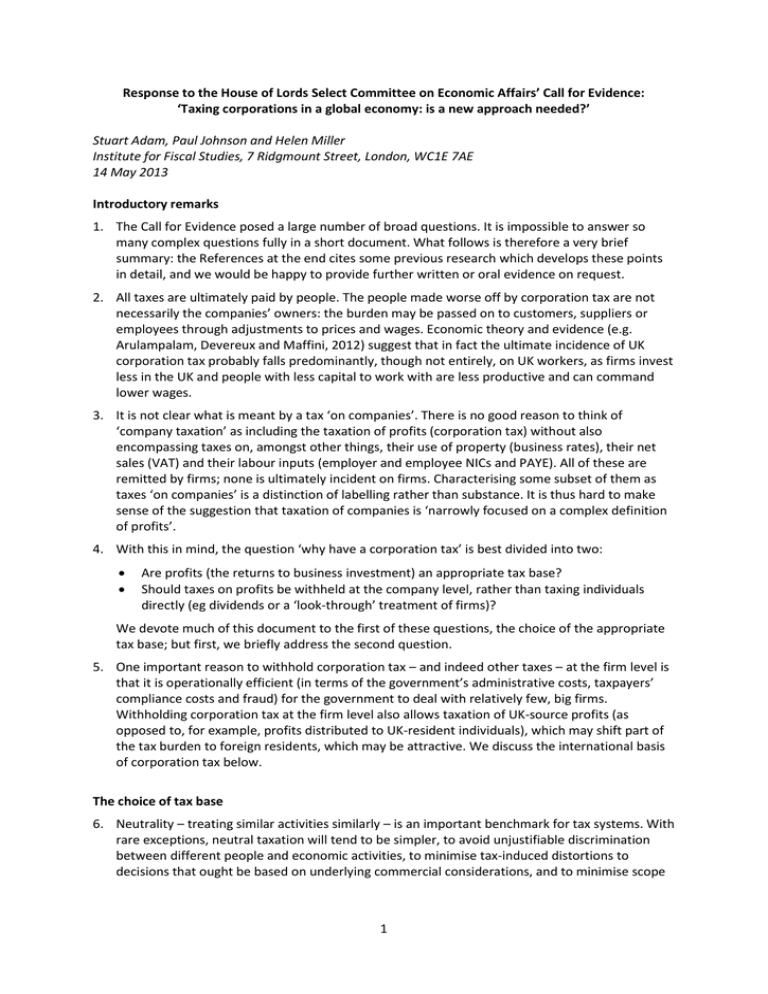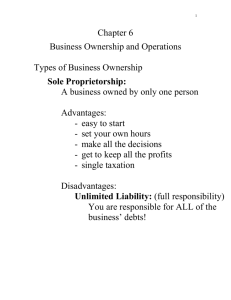Response to the House of Lords Select Committee on Economic... ‘Taxing corporations in a global economy: is a new approach...
advertisement

Response to the House of Lords Select Committee on Economic Affairs’ Call for Evidence: ‘Taxing corporations in a global economy: is a new approach needed?’ Stuart Adam, Paul Johnson and Helen Miller Institute for Fiscal Studies, 7 Ridgmount Street, London, WC1E 7AE 14 May 2013 Introductory remarks 1. The Call for Evidence posed a large number of broad questions. It is impossible to answer so many complex questions fully in a short document. What follows is therefore a very brief summary: the References at the end cites some previous research which develops these points in detail, and we would be happy to provide further written or oral evidence on request. 2. All taxes are ultimately paid by people. The people made worse off by corporation tax are not necessarily the companies’ owners: the burden may be passed on to customers, suppliers or employees through adjustments to prices and wages. Economic theory and evidence (e.g. Arulampalam, Devereux and Maffini, 2012) suggest that in fact the ultimate incidence of UK corporation tax probably falls predominantly, though not entirely, on UK workers, as firms invest less in the UK and people with less capital to work with are less productive and can command lower wages. 3. It is not clear what is meant by a tax ‘on companies’. There is no good reason to think of ‘company taxation’ as including the taxation of profits (corporation tax) without also encompassing taxes on, amongst other things, their use of property (business rates), their net sales (VAT) and their labour inputs (employer and employee NICs and PAYE). All of these are remitted by firms; none is ultimately incident on firms. Characterising some subset of them as taxes ‘on companies’ is a distinction of labelling rather than substance. It is thus hard to make sense of the suggestion that taxation of companies is ‘narrowly focused on a complex definition of profits’. 4. With this in mind, the question ‘why have a corporation tax’ is best divided into two: Are profits (the returns to business investment) an appropriate tax base? Should taxes on profits be withheld at the company level, rather than taxing individuals directly (eg dividends or a ‘look-through’ treatment of firms)? We devote much of this document to the first of these questions, the choice of the appropriate tax base; but first, we briefly address the second question. 5. One important reason to withhold corporation tax – and indeed other taxes – at the firm level is that it is operationally efficient (in terms of the government’s administrative costs, taxpayers’ compliance costs and fraud) for the government to deal with relatively few, big firms. Withholding corporation tax at the firm level also allows taxation of UK-source profits (as opposed to, for example, profits distributed to UK-resident individuals), which may shift part of the tax burden to foreign residents, which may be attractive. We discuss the international basis of corporation tax below. The choice of tax base 6. Neutrality – treating similar activities similarly – is an important benchmark for tax systems. With rare exceptions, neutral taxation will tend to be simpler, to avoid unjustifiable discrimination between different people and economic activities, to minimise tax-induced distortions to decisions that ought be based on underlying commercial considerations, and to minimise scope 1 for avoidance. The hurdle for departing from neutrality should be high, requiring a strong and clear justification. 7. Corporation tax, and the way it interacts with the rest of the UK tax system, is far from neutral. It affects a wide range of firm decisions, including: The choice of legal form for a business – whether to incorporate. Source of finance – debt finance costs (interest payments) are tax deductible while equity is not, incentivising firms to increase leverage. The level of investment – corporation tax discourages (equity-financed) investment by reducing the return, making some worthwhile investment opportunities unviable. Choice of assets – investment decisions are biased towards those assets for which the capital allowance regime is more generous relative to true economic depreciation. Risk-taking – the fact that the taxation of profits is not matched by symmetrically generous relief for losses discourages firms from undertaking risky projects. Firm location decisions – the corporate tax regimes in the UK and elsewhere affect both where firms locate real economic activity and where they report their taxable profits. 8. Some firms, and some decisions, are more responsive to taxation than others. There is a sizeable literature in empirical economics attempting to estimate the effects of taxation on firm decisions. To take just a few recent examples, Griffith, Miller and O’Connell (2011) show that corporate taxes affect where firms choose to locate the ownership of their intellectual property; Crawford and Freedman (2010) track how the rate of incorporations changed following various tax policy announcements; Cullen and Gordon (2007) show the effects of incomplete loss relief on the behaviour of US entrepreneurs; Bond and Xing (2010) estimate the effect of corporate taxes on investment. This literature is too large to summarise here; de Mooij and Ederveen (2008) provides a survey of empirical findings on a wide range of decisions. 9. Notwithstanding the damaging effects of the current corporation tax regime, taxing profits is strongly preferable to taxing turnover. Failing to allow deductions for the costs incurred in generating income would distort economic decisions, favouring low-cost-low-revenue activities over high-cost-high-revenue activities. The appropriate definition of taxable profits, however – how (if at all) it should differ from accounting profits – is more complex. 10. The Mirrlees Review (Mirrlees et al., 2011) argued for a tax on ‘economic rents’: one that levies no net tax on business activities that break even in present value terms, but taxes only profits in excess of a ‘normal’ (risk-free) rate of return on the funds invested in the company. 11. There are two broad approaches to achieving this: A Cash-Flow Corporation Tax (CFCT) – taxing firms’ net cash-flows. This is similar to a VAT (taxing firms’ sales less their input purchases), but allowing deduction of wages as an expense. An Allowance for Corporate Equity (ACE) – an allowance for the opportunity cost of equity finance (a risk-free interest rate multiplied by a measure of the stock of shareholders’ funds tied up in the company), similar to the deduction already given for the cost of debt finance. A similar system is currently in use in Belgium, and has previously been used elsewhere. It can be shown that these two approaches are closely related to each other: in simple cases the present value of a company’s tax payments will be the same. 12. Either of these approaches would wholly or largely resolve a number of problems with the existing corporation tax, regardless of the headline tax rate (as long as that rate were stable): Bias in favour of debt over equity finance Commercially viable investments being made unviable by taxation 2 Bias towards investing in assets that are treated more favourably by the capital allowances regime Bias towards current expenditure (which is fully tax-deductible) over capital expenditure (which is not) Sensitivity of effective tax rates to inflation They would not, however, prevent the headline rate of corporation tax from affecting the UK’s attractiveness relative to other countries as a destination for mobile investment or profits. 13. The Mirrlees Review favoured an ACE over a CFCT approach, because it would involve a less radical transition from the current system and because its neutrality is less sensitive to tax rate changes (although, on the other hand, it is somewhat more complicated and its neutrality is vulnerable to misspecification of what is the ‘normal’ return). 14. An alternative would be to move in the opposite direction by restricting interest deductibility. That would be markedly inferior: while it would address the debt-equity bias (‘levelling down’ rather than ‘levelling up’), it would either ignore or worsen all the other problems mentioned above. 15. The case for moving to a ‘rents tax’ is weaker if one assumes that a fixed amount of revenue must be raised within corporation tax, so that the cost of introducing an ACE (say) would have to be recouped through a higher statutory rate. We reject that restriction: while the government may require a given amount of revenue overall, all taxes are ultimately incident on real people and there is no economic reason to impose a revenue target for particular taxes because they are labelled as ‘corporate’. Taxing normal returns to equity-financed investments is a particularly inefficient way to tax people. It would be more efficient to raise that revenue directly (though higher income tax or VAT, say). The question of how high the statutory tax rate should be on returns in excess of the ‘normal’ rate is a separate issue, a balance between wanting a low tax rate to attract internationally mobile activities and wanting a high tax rate on highly-profitable activities that are stuck in the UK (which can be taxed heavily, since they will still be worthwhile as long as some ‘excess’ return is left over). 16. If, for political reasons, one accepts the unsatisfactory restriction that a fixed amount of revenue must be raised within corporation tax, one would have to weigh the advantages of ACE versus the status quo (or versus restricting interest deductibility) against the disadvantages of raising the headline tax rate to pay for it. This would be a finely balanced judgement, although on balance we would still prefer to see an ACE introduced than to see further cuts in the headline rate of corporation tax. The international basis of corporation tax 17. In line with international practice, UK corporation tax is levied largely on a ‘source basis’: it attempts to tax profits derived from UK production, rather than, for example, profits from selling to UK customers (a ‘destination basis’) or profits of UK-owned companies (a ‘residence basis’). 18. The source basis is a problematic – arguably even incoherent – basis for taxation of multinational companies. Conceptually, there is often no right answer to the question of what shares of profits are generated by activities in different countries. Suppose, for example, that a multinational firm has research laboratories in several countries, each of which makes an essential contribution to developing the firm’s unique product. Without any one of those subsidiaries, the product would not exist and profits would be zero; there is no sense in which we could say that, say, 30% of profits are created in country A, 50% in country B and 20% in country C. When determining how much the company ultimately producing the product should pay each of these affiliates for their contribution (the ‘transfer prices’), and therefore what taxable profits should be in each country, it would be hard to say that a particular decision made by the company was ‘wrong’. The ‘arm’s3 length pricing’ that is supposed to be the guiding principle – the price that would be charged between unrelated parties – is of little help in this case, not only because the intellectual property in question is never traded between unrelated parties (so that the arm’s-length price is unobservable), but because the individual contributions may have little or no value to an unrelated party despite making an important contribution to the firm in question. Indeed, more generally, an important reason why multinational companies exist is likely to be that they enjoy some advantage that cannot easily be replicated by arm’s-length trade between unrelated parties. All this makes it difficult to prevent firms choosing transfer prices that allocate profits to low-tax countries – and manipulation of transfer prices is only one of many ways in which multinational companies can take advantage of differences in corporate tax rates across countries. 19. This potential for multinationals to shift reported profits across countries comes on top of the potential for real economic activity to move across countries in response to differential tax rates. Source-based taxation therefore encourages (probably harmful) tax competition between countries and inefficient production patterns as production is located in response to tax rates rather than underlying commercial considerations. 20. One response to the problems with the current corporation tax would be to try to make sourcebased taxation work more satisfactorily than it does at present. An ACE would help somewhat, not just in terms of reducing distortions to domestic decision-making but also with some international aspects: for example, it would reduce the scope for companies to shift taxable profits out of the UK by using debt borrowed (and tax-deductible) in the UK to equity-finance subsidiaries operating (and taxed) in other jurisdictions with lower corporate tax rates. But it would not significantly alleviate (or exacerbate) some of the fundamental problems, e.g. over transfer pricing. More international co-operation, particularly adopting a Common Consolidated Corporate Tax Base (CCCTB) and formula-based allocation of taxable profits across EU member states, might help, although a CCCTB would be costly if companies’ participation were voluntary (since presumably only companies whose tax bills it reduced would participate) and politically difficult otherwise, and a profit allocation formula could introduce new distortions as firms try to minimise their tax liabilities by manipulating whatever components are included in the formula. We do not have the expertise to judge whether international transfer pricing guidelines could be improved – or enforced better – but such changes will only ever have limited success as they cannot solve the underlying problem that there is no coherent way to allocate profits by source – no objective measure of how much of a multinational’s profits derive from production in each country. 21. A different approach would be to move away from source-based taxation. Auerbach, Devereux and Simpson (2010) advocate moving to a destination-based CFCT. This proposal has strong attractions in principle, but is so far removed from current UK and international practice that it seems fanciful in practice. However, a similar effect could be achieved by reducing rates of corporation tax and increasing rates of VAT (which is already destination-based and is a cashflow tax to boot, thus killing two birds with one stone), while at the same time reducing employer NICs rates (recognising that wage costs are deductible from corporation tax but not VAT). VAT is not without problems of its own, from the tax base (excessive and inappropriate use of zero/reduced rates and exemptions) to implementation (HMRC estimates that the ‘tax gap’ is a larger share of revenue for VAT than any other major tax) and international issues (such as cross-border – especially online – shopping and ‘carousel’ frauds), which would be worsened by rate increases; but these problems may be less severe than those bedevilling corporation tax. In practice, lower rates of corporation tax and higher rates of VAT is broadly the direction in which the UK and most other developed countries have been moving for decades, whether as a conscious strategic decision or by ‘accident’ (ad hoc pragmatic steps), though other factors such 4 as base-broadening reforms and (until recently) financial sector profitability have offset much of the UK’s revenue loss from corporation tax rate reductions. 22. In reality, a combination of the two approaches will be needed. Corporation tax is not going to be moved to a destination basis overnight. It probably will, and probably should, continue to be reduced in favour of greater use of other taxes, limiting the damage caused by distortions to domestic and international decisions. But any such trend is likely to be gradual, so the need to operate a source-based corporation tax will remain for the foreseeable future, and it probably should (and hopefully will!) be improved by making it work better – and adopting an ACE. The relationship between corporate and personal income taxation and the small business context 23. Individuals and small businesses can often choose between employment, self-employment and forming a company, and between taking salary, dividends and capital gains. Tax can be one factor influencing those choices, but ideally it should not be. Neutrality is again the crucial benchmark: taxing income (and capital gains) differently according to the legal form in which it arises will tend to be unfair, complex, distortionary and prone to avoidance. Providing preferential tax treatment for activities that take certain legal forms scatters benefits very widely and is unlikely to be a well-targeted way to encourage any kind of socially beneficial ‘entrepreneurship’. 24. Aligning statutory tax rates across different sources of income (and capital gains) is central to achieving neutrality. The combined rates of corporate and shareholder taxation should equal the tax rates levied on employment (and self-employment, and other) income. This would require a number of changes from the current system, including significant increases in the headline tax rates on dividends, capital gains and self-employment income, all of which are currently treated more generously than employment income because they are not subject to full (employee + employer) NICs. It would also involve applying lower rates of capital gains tax on shares than on other assets, reflecting corporation tax already paid, and removing entrepreneurs’ relief (which applies a reduced rate to business assets only where they are owner-managed and regardless of corporate status, creating large biases). To maintain alignment of corporate-source income with non-corporate income, note that (with constant labour income tax rates) any future changes in corporation tax rates would then need to be accompanied by offsetting changes in personal tax rates on dividends and capital gains on shares. 25. However, to achieve neutrality this alignment of tax rates should form part of an overall package to rationalise capital taxation as proposed by the Mirrlees Review, including the introduction of allowances for amounts saved/invested (an ACE and its analogue in the personal tax system, a Rate of Return Allowance (RRA)). Taking the adjustment to statutory tax rates and the introduction of an ACE and RRA together, It is not clear whether this package would increase or reduce the tax burden overall, but it would greatly increase the efficiency with which the revenue is raised. Conclusion 26. Corporation tax needs to be seen in the context of the tax system as a whole. It is impossible to think sensibly about it without recognising three essential points: (1) like VAT, PAYE income tax and NICs it is remitted by companies but is ultimately incident upon households; (2) in a domestic context it distorts decisions by (amongst other things) reducing the return to capital and hence reducing investment, and favouring debt over equity finance; (3) maintaining a source-based corporation tax introduces problems in the international allocation of profits to which there is probably no solution in principle – while some improvements may be possible, 5 complex rules, uncertainty and ‘manipulation’ of accounts to show profits in low-tax jurisdictions are probably inevitable. 27. Steps towards reform need to recognise these facts. At the domestic level introducing an ACE would avoid making worthwhile investments unviable, would end the bias in favour of debt and could, as part of a wider reform, help align the taxation of different economic activities and legal forms. At an international level tax competition and the problems inherent in a source-based approach are likely to continue to drive down headline corporate tax rates and increase reliance on other forms of tax. References Arulampalam, W., Devereux, M. P. and Maffini, G. (2012), ‘The direct incidence of corporate income tax on wages,’ European Economic Review, 56(6), 1038-1054. Auerbach, A., Devereux, M.P. and Simpson, H. (2010), ‘Taxing corporate income’, in J. Mirrlees, S. Adam, T. Besley, R. Blundell, S. Bond, R. Chote, M. Gammie, P. Johnson, G. Myles and J. Poterba (eds), Dimensions of Tax Design: The Mirrlees Review, Oxford University Press for the Institute for Fiscal Studies. Bond, S. and Xing, J. (2010), ‘Corporate Taxation and Capital Accumulation’, Oxford University Centre for Business Taxation, Working Paper WP10/15. Crawford. C. and Freedman, J. (2010), ‘Small business taxation’, in J. Mirrlees, S. Adam, T. Besley, R. Blundell, S. Bond, R. Chote, M. Gammie, P. Johnson, G. Myles and J. Poterba (eds), Dimensions of Tax Design: The Mirrlees Review, Oxford University Press for the Institute for Fiscal Studies. Cullen, J. and Gordon, R. (2007), ‘Taxes and entrepreneurial risk-taking: theory and evidence for the US’, Journal of Public Economics, 91, 1479–1505. Griffith, R., Hines, J. and Sørensen, P.B. (2010), ‘International capital taxation’, in J. Mirrlees, S. Adam, T. Besley, R. Blundell, S. Bond, R. Chote, M. Gammie, P. Johnson, G. Myles and J. Poterba (eds), Dimensions of Tax Design: The Mirrlees Review, Oxford University Press for the Institute for Fiscal Studies. Griffith, R., Miller, H. and O’Connell, M. (2011), ‘Corporate taxes and the location of intellectual property’, CEPR Discussion Paper DP8424. Mirrlees, J., S. Adam, T. Besley, R. Blundell, S. Bond, R. Chote, M. Gammie, P. Johnson, G. Myles and J. Poterba (2011) Tax by Design: The Mirrlees Review, Oxford University Press for the Institute for Fiscal Studies. de Mooij, R.A. and Ederveen, S. (2008), ‘Corporate tax elasticities: a reader’s guide to empirical findings’ Oxford Review of Economic Policy, 24(4) 680–697. 6


